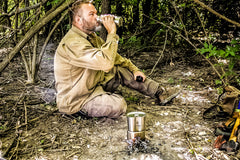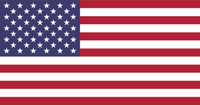To Boil or Not to Boil?
Waterborne disease is a risk for travelers who visit countries that have poor hygiene and inadequate sanitation, and for those in the wilderness relying on surface water in any country, including the United States. In today’s world of Large Farms for both Livestock and crops, the threat goes beyond just pathogens, it also involves poisons from pesticides and fertilizers. In addition, humans and animals, are also a source of microorganisms and toxins that contaminate water sources and cause intestinal infections or poisonings.
 During excursions into nature as well as times when we are caught in an emergency scenario, we must decide what will be the best method to de-contaminate our water sources. Carrying water from home is always the best measure of defense in the short term and you should consider that 1 quart or liter will not go far on a hot day or in the event of an overnight stay. Combine this with the fact that we may use water for cooking as well and most of us will not wander off trail carrying a gallon or more of water, however; there may be a real need to consume that much in a given 24-hour period.
During excursions into nature as well as times when we are caught in an emergency scenario, we must decide what will be the best method to de-contaminate our water sources. Carrying water from home is always the best measure of defense in the short term and you should consider that 1 quart or liter will not go far on a hot day or in the event of an overnight stay. Combine this with the fact that we may use water for cooking as well and most of us will not wander off trail carrying a gallon or more of water, however; there may be a real need to consume that much in a given 24-hour period.
So, in a world filled with the latest techno gadgets and chemicals to treat our water, what do we do? BOIL! Yes, boiling your water is the ONLY 100% guarantee you have to kill waterborne pathogens in ground source collected water. You make ask, “What about chemicals?” Well, that is another issue altogether as boiling will not remove chemical contaminants. To be as safe as possible we must first filter and then boil water for the best results. There are a variety of good filter systems on the market today, but we must remember that no filter system or chemical alone is capable of killing ALL water born organisms.
So as far as filtering goes, buy the best one you can afford but do not rely solely on filtration for killing all waterborne pathogens because that filter doesn’t exist!
You be wondering, “how long do I need to boil?” and “what is the best way to collect the safest possible water?” There are actually several collection methods you can use but a personal favorite is to use one container (Metal) for collecting/boiling and another container for holding and cooling the potable result. In this manner, you are sterilizing the container (in a manner of speaking) by the heat of the fire. The Wilderness Medical Society and the CDC (Center for Disease Control) agree that temperatures of 140-160 degrees Fahrenheit are sufficient to kill Water Borne Pathogens over an average boil time of 2 to 3 minutes. However, keep in mind the average time mention is based on normal elevation (below 6,000 feet). At higher Elevation, the time is extended due to the fact that water boils at a lower temperature in less oxygen-rich environments.

With the use of purification tablets, its suggested any water bottle or canteen device carried should be a standard quart or liter, and then there is no confusion or worry. Too many water bottles today are made to be aesthetically pleasing and utterly useless for emergencies. If you have the choice of only one Bottle it should always be metal that way you can boil in it if possible and then let the container cool before consumption. A stainless steel military style canteen & nesting cup or a stainless steel bottle and nesting cup would be an ideal solution to this.
At this point, you now have an issue with time? It takes a certain amount of time for chemicals to effectively decontaminate water. So, without a watch or sundial how do you know? Wait as long as you think 15 or 30 minutes is and then wait twice as long!
Now you can see why boiling is the preferred option. It’s typically safer, takes less time, and is a simpler process.
Drinking suspected water sources is a serious consideration. Some say it’s better to get out alive and be sick later than not make it due to dehydration. However, being prepared is the always gives you the best options!






My basic setup is a 40oz steel water bottle nested in whatever cheap WalMart steel cup they sell in the camping section. A penny stove filled with either fiberglass insulation or carbon mat (welder’s heat cloth) works great nested between the cup and bottle. I prefer 190 Proof everclear as fuel, however, 90% rubbing alchohol is also an option. I store my fuel in “airline bottles” – the mini versions of common vodka/whiskey/rum bottles… I like everclear because I won’t risk putting toxic denatured alchohol in a bottle that one might mistake as safe for drinking. I can fit a couple bottles easily into the mouth of my 40oz steel bottle, so the entire it is the size of a coffee thermos. Add a cheap micro striker/ferro key, purification/iodine/whatever tablets and some coffee filters between the bottle and cup – you have as minimal a kit as i can imagine.
I learn something new everytime i watch one of your videos, your vast knowledge, and skills of the woods is unmatched , and im sure too learn and gain knowledge from you and your instructors to injoy the woods as i would like too as you have in your lifetime, God Bless and I’ll see you in the woods.
Good Article Dave !!!
If it is one of your canteens I suggest boiling water in the canteen with the cap off. This will also sanitize the canteen.
Good to see the blog active again. The past few months have held a wealth of information as well as great refresher material on most of the basics. For someone like me who is just getting into this, it is great to see multiple takes on the same issues, each slightly different, but yet the same basic message. It builds confidence in the material being presented. Thanks again – Kodiak114
Cryptosporidium is killed by boiling. (my 2 cents) my question is what rids chemicals ie round up, pesticides and heavy metal? filter w/ sand and activated charcoal or distillation? ?